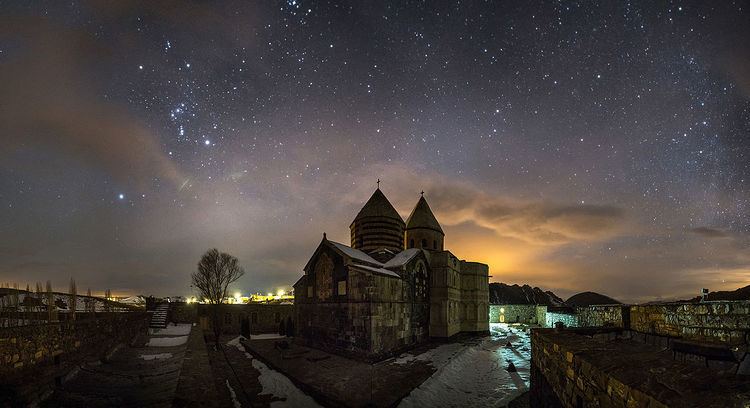Location Iran Criteria ii, iii, vi UNESCO region Asia-Pacific | Type Cultural Reference 1262 UNESCO World Heritage Site inscription 2008 | |
 | ||
Address St. Thaddeus West Azerbaijan,, Iran Similar Saint Stepanos Monastery, Chapel of Dzordzor, Takht‑e Soleymān, St Mary Church - Urmia, Makravank Monastery | ||
The Monastery of Saint Thaddeus (Armenian: Սուրբ Թադէոսի վանք – Surb Tadeosi vank'; Persian: کلیسای حضرت تادئوس – Kelisā-ye Ḥaẓrat-e Tādeus) is an ancient Armenian monastery in the mountainous area of West Azerbaijan Province, Iran.
Contents
Also known as Kara Kilise (the "Black Church") (Azerbaijani: Qara Kilsə; Persian: Qare Kelisā – قره کلیسا), it is located about 20 kilometers from the town of Chaldiran. The monastery and its typical Armenian conical roofs are visible from long distances.
History and architecture
According to the tradition of the Armenian Apostolic Church, Saint Thaddeus, also known as Saint Jude, (not to be confused with Judas Iscariot), evangelized the region of Armenia and Persia. Thaddeus suffered martyrdom in Armenia, according to the same tradition, and is revered as an apostle of the Armenian Church. Legend has it that a church dedicated to him was first built on the present site in AD 68.
Little remains of the monastery's original structure, as it was extensively rebuilt after an earthquake damaged it in 1319. Nevertheless, some of the parts surrounding the altar apse date from the 10th century.
Much of the present structure dates from 1811, when the Qajar prince Abbas Mirza aided renovations and repairs. Simeon, Father Superior of the monastery, added a large narthex-like western extension to the church.
The western extension duplicates the design of Etchmiadzin Cathedral, the mother church of the Armenian Apostolic Church. The 19th century additions were constructed from ashlar sandstone. The earliest sections are of black and white stone, hence its Turkic name Qara Kilse, meaning "the Black Church."
In July 2008, the Monastery of Saint Thaddeus was added to UNESCO's World Heritage List, along with two other Armenian monuments in the same province: the Monastery of Saint Stepanos and the Chapel of Dzordzor.
Apostles Thaddeus and Bartholomew
According to Armenian Church tradition, the Apostles Thaddeus and Bartholomew traveled through Armenia in AD 45 to preach the word of God, where many people were converted and numerous secret Christian communities were established.
The ancient Christian historian Moses of Khorene told the following story, considered a legend by most modern historiographers. Thaddeus converted King Abgar V of Edessa. After his death, the Armenian kingdom was split into two parts. His son Ananun crowned himself in Edessa, while his nephew Sanatruk ruled in Armenia. About AD 66, Ananun gave the order to kill Saint Thaddeus in Edessa. The king's daughter Sandokht, who had converted to Christianity, was martyred with Thaddeus. Her tomb is said to be located near the Qara Kelisa.
Events
The annual ceremony and pilgrimage in the St. Thaddeus Monastery was held 14-16 July 2016. It was held by the Armenian Diocese of Azerbaijan, Iran.
